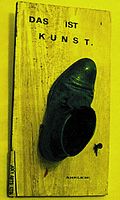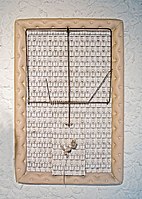Assemblage

Assemblage originally became a term with a special meaning in the visual arts , denoting a type of work of art: collages with plastic objects attached to a base plate. This creates works of art with a relief-like surface. Three-dimensional objects can also be referred to as assemblages. The term is also used as an analogy in other areas, for example in postmodern philosophy.
art
In painting, the principle of assemblage was anticipated as early as the 16th century by Giuseppe Arcimboldo , who arranged flowers, fruits or vegetables, but also inorganic objects such as books into surprising portraits or still lifes in his paintings . An early form of assemblage is the Trencadí technique, popular in modernist architecture (Art Nouveau in Catalonia) , in which large fragments of ceramic tiles, marble or shards of dishes and bottles are formed into mostly abstract motifs.
In sculpture, Auguste Rodin in particular introduced the assemblage technique as an innovative way of working from around 1895 . The artist created a reservoir of casts, reductions and enlargements of already created works, from which he was able to develop new contexts of meaning by recombining bodies, heads, arms, legs and other sculptural elements.
Later, but before the term was established in art history, artists such as Marcel Duchamp , Pablo Picasso , Louise Nevelson , Wolfgang Paalen , Raoul Hausmann , Johannes Baader , Max Ernst and Elsa von Freytag-Loringhoven worked with the combination of preformed natural or manufactured materials, objects or fragments .
Above all, the Dada movement has expanded the principle of collage in the context of its anti-artistic grotesque designs three-dimensionally - from the individual work to the installation of the exhibitions. In a pyramidal mixture of sound poems, newspapers, Dada publications, wheels, even a Manichino, the great Plasto-Dio-Dada drama under the title Germany's Greatness and Fall or the fantastic life story of Oberdada by Johannes Baader comes up as a space-consuming installation in 1920 the First International Dada Fair gained its own status in the avant-garde for the first time. It also inspired Kurt Schwitters to create his Merz-Bau , an assemblage that has been growing in his Hanover house since 1923 and that melted the gold of art from everyday materials.
Picasso's use of a wide variety of found materials (wood, metal, glass) and objects that he combined to form a new whole is well known. Examples are Picasso's bull skull (Tête de taureau), from 1940 and 1942, a combination of bicycle handlebar and saddle, the absinthe glass or the woman with a stroller . Picasso used the artistic process as early as 1912 for three-dimensional cubist constructions.
The term assemblage was adopted by Jean Dubuffet in the 1950s to designate one of his groups of works. In 1961 it was taken over by William C. Seitz, one of the curators of the MoMA exhibition The Art of Assemblage . As a result of this well-received exhibition, the term entered the art history literature.
Artists such as Alberto Burri , Louise Bourgeois , Joseph Cornell , Edward Kienholz , Louise Nevelson , Martial Raysse , Hans Salentin and Kurt Schwitters incorporated this further development of the collage into their work.
Daniel Spoerri developed his trap pictures as assemblages, Robert Rauschenberg combined assemblage with painting to create Combine Paintings , while Christo and Jeanne-Claude developed the assemblage further into packaging art . The accumulation of the Nouveaux Réalistes can also be seen as a further development or a related phenomenon. Wolf Vostell began to integrate televisions into his object images in the late 1950s . He created sculptures that combined painting, auto parts, televisions, video cameras, and monitors.
Werner Stürenburg , No. 5 , 1968
Lubo Kristek , De-Noise Aesthetics of Luxury Saving , 1976
philosophy
The French authors Gilles Deleuze (1925–1995) and Félix Guattari (1930–1992) have used the term “structure” ( Gilles Deleuze, Félix Guattari : Tausend Plateaus , Berlin 1992, pp. 698-700.) (OK “Agencements "( Gilles Deleuze, Félix Guattari : Mille Plateaus , Paris 1980, pp. 629-630.), Translated into English with" Assemblages "( Gilles Deleuze, Félix Guattari : A Thousand Plateaus , Minneapolis 1987, pp. 503-505.) ) constructed a philosophical theory: You understand by structure no collections of the same kind, but "unformed matter, destratified forces and functions" ( Gilles Deleuze, Félix Guattari : Tausend Plateaus , Berlin 1992, p. 699.). In doing so, they represent the thesis that certain mixtures of technical and administrative practices open up new spaces and make them understandable by deciphering and re-encoding territories. The Mexican philosopher Manuel De Landa (* 1952) developed this view further in a theory of assemblage. The American sociologist and economist Saskia Sassen, on the other hand, does not use the term to build theory, but in a descriptive way.
literature
Visual arts
- Hanne Bergius : Dada's laugh. The Berlin Dadaists and their actions , Anabas-Verlag, Giessen 1989, ISBN 978-3-87038-141-7 .
- Hanne Bergius: assembly and metamechanics. Dada Berlin - Aesthetics of Polarities (with reconstruction of the First International Dada Fair and Dada Chronology), Gebr. Mann Verlag, Berlin 2000, ISBN 978-3-7861-1525-0 .
- Hanne Bergius: Dada triumphs! Dada Berlin, 1917–1923. Artistry of Polarities. Montages - Metamechanics - Manifestations. Translated by Brigitte Pichon. Vol. V. of the ten editions of Crisis and the Arts. The History of Dada, ed. by Stephen Foster, New Haven, Conn. et al., Thomson / Gale 2003, ISBN 978-0-8161-7355-6 .
- William C. Seitz: The Art of Assemblage. Exhibition. The Museum of Modern Art, New York 1961.
- Stephan Geiger : The Art of Assemblage. The Museum of Modern Art, 1961. The new reality of art in the early sixties. Dissertation University of Bonn 2005. Schreiber, Munich 2008, ISBN 978-3-88960-098-1 .
philosophy
- Taylor Webb: Teacher Assemblage. Sense Publishers, United States 2009, ISBN 978-90-8790-779-2 .
- Dominik Nagl: No Part of the Mother Country, but Distinct Dominions. Legal Transfer, State Formation, and Governance in England, Massachusetts, and South Carolina, 1630–1769. LIT, Berlin 2013, pp. 26-29. ISBN 978-3-643-11817-2 . On-line
Web links
Individual evidence
- ^ William C. Seitz: The Art of Assemblage. Exhibition. The Museum of Modern Art, New York 1961.
- ↑ Hanne Bergius: Dada's laughter. The Berlin Dadaists and their actions . Anabas-Verlag, Giessen 1989, ISBN 978-3-87038-141-7 .
- ^ Hanne Bergius: Assembly and Metamechanics. Dada Berlin - Aesthetics of Polarities (with reconstruction of the First International Dada Fair and Dada Chronology) . Gebr. Mann Verlag, Berlin 2000.
- ↑ Assemblage. oxfordreference.com, accessed December 1, 2012 : "The practice dates back to Picasso's Cubist constructions made from 1912 onwards."
- ↑ Gilles Deleuze, Félix Guattari: Tausend Plateaus , Berlin 1992, p. 699.
- ↑ Manuel De Landa: A New Philosophy of Society: Assemblage Theory and Social Complexity. Continuum, London 2006.
- ↑ Saskia Sassen: The dialectic of world and nation. To transform territory, authority and law. In: Blätter for German and international politics (ed.): The end of casino capitalism? 24 contributions, by Elmar Altvater, Samir Amin, Mike Davis, Heiner Flassbeck, Nancy Fraser, Thomas L. Friedman, Saskia Sassen, Harald Schumann, Ernst Ulrich von Weizsäcker and others. a. Blätter Verlag, Berlin 2009, ISBN 978-3-9804925-5-3 .

